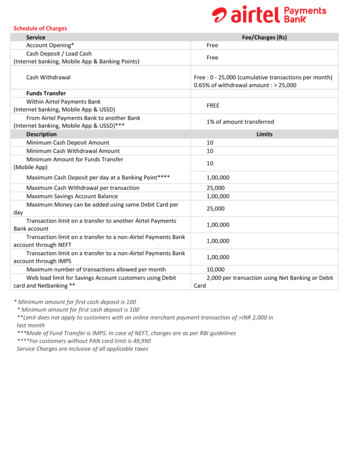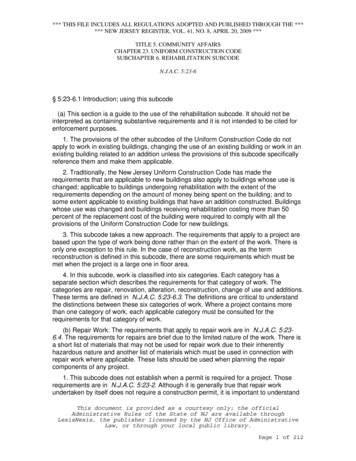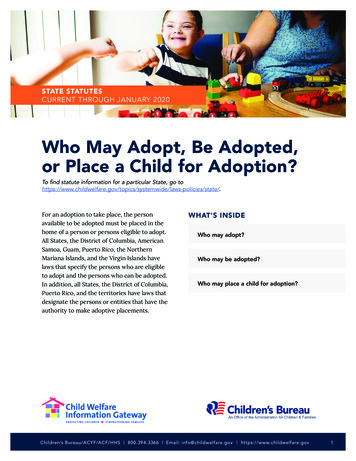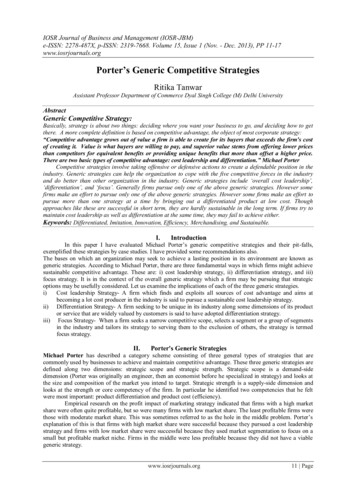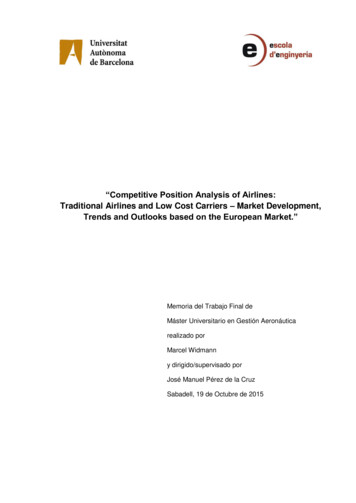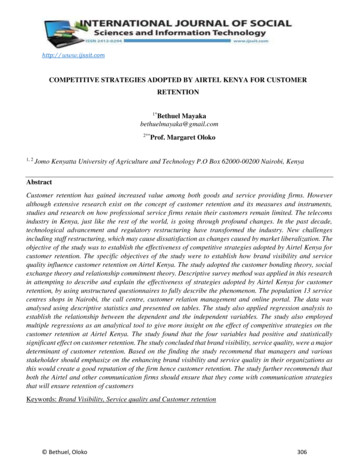
Transcription
http://www.ijssit.comCOMPETITIVE STRATEGIES ADOPTED BY AIRTEL KENYA FOR CUSTOMERRETENTION1*Bethuel Mayakabethuelmayaka@gmail.com2**Prof. Margaret Oloko1, 2Jomo Kenyatta University of Agriculture and Technology P.O Box 62000-00200 Nairobi, KenyaAbstractCustomer retention has gained increased value among both goods and service providing firms. Howeveralthough extensive research exist on the concept of customer retention and its measures and instruments,studies and research on how professional service firms retain their customers remain limited. The telecomsindustry in Kenya, just like the rest of the world, is going through profound changes. In the past decade,technological advancement and regulatory restructuring have transformed the industry. New challengesincluding staff restructuring, which may cause dissatisfaction as changes caused by market liberalization. Theobjective of the study was to establish the effectiveness of competitive strategies adopted by Airtel Kenya forcustomer retention. The specific objectives of the study were to establish how brand visibility and servicequality influence customer retention on Airtel Kenya. The study adopted the customer bonding theory, socialexchange theory and relationship commitment theory. Descriptive survey method was applied in this researchin attempting to describe and explain the effectiveness of strategies adopted by Airtel Kenya for customerretention, by using unstructured questionnaires to fully describe the phenomenon. The population 13 servicecentres shops in Nairobi, the call centre, customer relation management and online portal. The data wasanalysed using descriptive statistics and presented on tables. The study also applied regression analysis toestablish the relationship between the dependent and the independent variables. The study also employedmultiple regressions as an analytical tool to give more insight on the effect of competitive strategies on thecustomer retention at Airtel Kenya. The study found that the four variables had positive and statisticallysignificant effect on customer retention. The study concluded that brand visibility, service quality, were a majordeterminant of customer retention. Based on the finding the study recommend that managers and variousstakeholder should emphasize on the enhancing brand visibility and service quality in their organizations asthis would create a good reputation of the firm hence customer retention. The study further recommends thatboth the Airtel and other communication firms should ensure that they come with communication strategiesthat will ensure retention of customersKeywords: Brand Visibility, Service quality and Customer retention Bethuel, Oloko306
International Journal of Social Sciences and Information TechnologyISSN 2412-0294Vol IV Issue V, May 20181.1 IntroductionThe fundamental importance of strategies is that the business environment is dynamic. Therefore, regardlessof the size and the scale, every organization needs to adopt well planned strategies to survive and compete inthe market and try to optimize for tomorrow following the trend of today. Strategies have been defined as thedeliberate set of actions to achieve competitive advantage, giving coherence and direction to the organization(O’Regan and Ghobadian, 2005). The world has taken cognizance of the emergence of the service industry asa prominent contributor to its economy over the last century. A number of countries in the last few decadeshave experienced a dramatic change in the importance of services and the role of the services sector in theireconomies (Sharma, 2002). The ultimate goal of service industry is the satisfaction of its customers becausetheir satisfaction can somehow make them to come again. In today's challenging economy and competitivebusiness world, retaining your customer base is critical to your success. Customer retention and satisfactiondrive profits. It's far less expensive to cultivate your existing customer base and sell more services to them thanit is to seek new, single-transaction customers.All company revenue is achieved from two groups of customers-new and repeat customers. It is substantiallymore cost-effective to retain existing customers than attract new ones. Existing customers have known andidentified needs that have been satisfied by the organizations products or services in the past. By focusing theorganizations marketing strategy on the profitable segments of their customer base an organization willnormally produce most of the required revenue and increase their market share without investing in acquiringnew customers which is much more expensive than retaining old ones. Loyal customers not only repurchase,but also advocate products and services to their friends pay less attention to competitive brands and often buyproduct and service line extensions (Baumeister, 2002). Most surveys across industries show that keeping oneexisting customer is 5 to 7 times more profitable than attracting a new one. If a business creates and keepscustomers in a cost-effective way, it will make a profit while continuing to survive and thrive. If, for anyreason, a business fails to attract or sustain a sufficient number of customers, it will experience losses(Nankervis, 2005). In order to increase customer retention and the benefits that come along with retaining loyalcustomers, firms implement retention strategies or plans to get their customers to renew their loyal relationshipto the firm year after year (Levin, 2007).To develop effective retention strategies an organization has to have an in depth knowledge of customersbehaviour and needs. Loyalty is a physical and emotional commitment given by customers in exchange fortheir needs being met (Stone et al., 2002). Customer loyalty that leads to retention will develop over time ifthe parameters for the relationship are planned and implemented correctly. In a democratized market it is thequality and depth of the customers' relationships-physically and psychologically that ultimately differentiatesbetween brands (Burnett, 2004). Customer retention refers to keeping a client’s business rather than have theclient use competitors' services or products. Repeat customers are people who buy from you again and again.Customer retention embodies repeated behaviour and reflects relationship continuation. Customer retention isan essential part of customer relationship management and organizations must take this into account (Wanjau,2013). The longer a customer stays with an organization the more utility the customer generates to theorganization. Maintaining high levels of satisfaction will not, by itself, ensure customer loyalty. Organizationslose satisfied customers who have relocated, retired, or no longer need certain services. As a consequence,retaining customers becomes a priority (Wanjau, 2013). Bethuel, Oloko307
International Journal of Social Sciences and Information TechnologyISSN 2412-0294Vol IV Issue V, May 20181.1.1 Telecommunication Sector in KenyaThe telecoms industry in Kenya, just like the rest of the world, is going through profound changes. In the pastdecade, technological advancement and regulatory restructuring have transformed the industry. Markets thatwere formerly distinct, discrete and vertical have merged across their old boundaries with a massive investmentof capital - much of it originating from private sector participants. The result is; new markets, new players, andnew challenges including staff restructuring, which may cause dissatisfaction as changes caused by marketliberalization.Market liberalization efforts have also picked up ensuring the successful partial privatization of Telkom KenyaLtd (December 2007), divestment of Government of Kenya’s 25% stake in Safaricom Ltd through a publiclisting (May 2008), and the launch of a fourth mobile operator Econet Wireless Kenya (November, 2008). Thishas resulted into some of the world’s best known telecommunication providers Vodafone, Bharti AirtelInternational, France Telecom, and Essar Communications through their investments in Safaricom Limited,Telkom Kenya Limited and Econet Limited respectively - being major players in the Kenyan market. Ongoinginfrastructural developments by operators have largely been focused on network expansion for increasednationwide coverage (Price Waterhouse Coopers, 2014).Airtel Kenya is a subsidiary of Bharti Airtel of an Indian Multinational telecommunications Services Companyheadquartered in New Delhi, India. Bharti Airtel is now the third largest mobile operator in the world withover 303 million customers across 20 countries in Asia and Africa. The history of Airtel Kenya dates back tothe year 2000 when it entered the Kenya market under brand name Kencell which was later rebranded in 2004to Celtel Kenya. Celtel Kenya was later acquired by Zain group in 2005. On June 2010 the Zain was acquiredby Bharti Airtel and rebranded as 'Airtel Kenya'.Its current name was adopted after Bharti Airtel bought out the Africa mobile operations of Kuwaititelecommunications firm Zain. The company offers mobile voice & data services, fixed line, high speedbroadband, turnkey telecom solutions for enterprises and national & international long distance services tocarriers with market share of 22.6%. It acquired Yu Mobile subscribers in November 2014. It is the firsttelecommunications operator in Kenya to host mobile virtual network operators (MVNOs) in the countryAirtel Kenya is a licensed mobile operator in Kenya having been licensed by the CommunicationsCommission of Kenya to offer mobile telephony services in 2000. From its inception the Company prides itselfof being the most innovative mobile phone operator company in Kenya. This is attested by the many productsthat it offers namely; Value Added Services (VAS), Airtel Money, Prepaid and Postpaid plans, One Network,3.75G Network, Blackberry devices and services, International roaming, Local and international textmessaging, 24-hour customer care center, Internet access, Directory enquires, SMS information services,Mobile Top up and Me2U services.1.2 Problem statementStrategies are adopted by organizations in order to achieve a more favourable position. The current high levelof competition amongst businesses necessitates organizations to implement sound strategies to remaincompetitive. To adopt effective strategies, managers in an organization need to be aware of realities in thebusiness environment. Strategy adoption thus begins with scanning of the external as well as internalenvironment of the organization (Mbati, 2015). The benefits for customer retention has been of great effectand hence worth investing into by firms. Customers over the world have been reported to comfortably stick totheir current suppliers as long as they receive higher perceived value to what they are actually paying for. Bethuel, Oloko308
International Journal of Social Sciences and Information TechnologyISSN 2412-0294Vol IV Issue V, May 2018Customer satisfaction has been proven to lead to desirable results such as attitude change, repeat purchase, andbrand loyalty, Lower costs of attracting new customers and handling returns and complaints.Over the last 16 years of operation in Kenya, Airtel Company has striving to penetrate the competitive marketby various means. The company has been rated among the cheapest in provision of service as compared to itsbig rivals in the market Safaricom and Telkom Kenya. the company has enhanced it services though provisionof; Value Added Services (VAS), free Airtel Money, Prepaid and Post-paid plans, One Network, 3.75GNetwork, Blackberry devices and services, International roaming, Local and international text messaging, 24hour customer care centre, Internet access, Directory enquires, SMS information services, Mobile Top up andMe2U services. However statistics from the Telecommunication report (2015) and Communication authorityof Kenya (CAM), clearly indicates that the company has experiences a lot of customer fluctuation s than itscompetitor which has lowered the profitability. Despite of the much effects and strategies underlined by Airtelto penetrate the company, they still lug behind. This has raised an alarm on the formulation of strategic planon customer retention by the company. Many firms have expended much of their resources in customeracquisition and at times ignoring customer retention knowingly or unknowingly. The benefits for customerretention have been seen to be of great effect and hence worth investing into by firms.Studies have reviewed the concept of customer retention in different contexts. Muturi (2004) researched onfactors that determine customer loyalty to a mobile phone service provider the case of mobile phone users inNairobi and found out that the major factor are service quality, price indifference and perceived value. Tanui,(2007) conducted a survey of customer loyalty programs applied by petrol stations in Nairobi and found thatthe main factors that contributed to customer loyalty to their products were attractiveness of the brandpersonality and perceived quality while Mungai, (2008) studied the factors that determine customer loyalty thecase of the port of Mombasa and found out that Customer Satisfaction, perceived quality and brand loyaltywere the main determinant. Wekunda (2006), in a study on customer relation strategies used by internetservices providers in Kenya. The study generalised the strategies and did not provide specific aspects suitablefor customer retention. Thought quite has been written about competitive strategies on customer retention, verylittle has been done on this specific strategies brand visibility, services quality, customer recognition andtechnology adoption (Kotler and Keller, 2006). The ultimate goal of this study is to bridge the gap betweencompetitive strategies and customer retention by review some of the key competitive strategies adopted byAirtel Kenya for customer retention.1.3
COMPETITIVE STRATEGIES ADOPTED BY AIRTEL KENYA FOR CUSTOMER RETENTION 1*Bethuel Mayaka bethuelmayaka@gmail.com 2**Prof. Margaret Oloko 1, 2 Jomo Kenyatta University of Agriculture and Technology P.O Box 62000-00200 Nairobi, Kenya Abstract Customer retention has gained increased value among both goods and service providing firms. However although extensive
